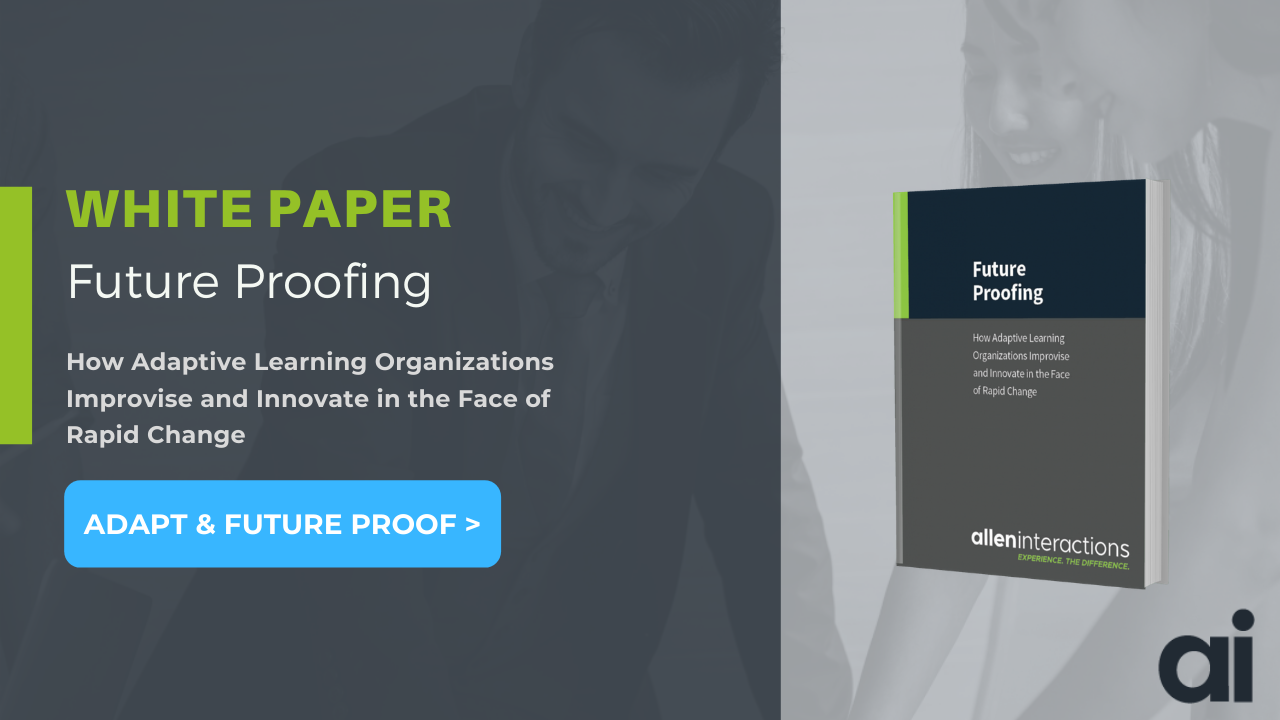

Relevance, Resilience, and Revenue: The Mission of a Chief Learning Officer
By Dr. Christina Barss | March 30, 2020 | Custom Learning | 1 Comment
Why do you think most companies struggle with L&D?
There is no explicit correlation to the bottom line. Learning and Development (L&D) is not seen as driving the business. It is seen as a ‘nice to have’ not a ‘need to succeed.’ That is the old school L&D mentality prior to the Internet (yes, I said that!).
Today when our leaders and employees have a business question or concern, they use Google or YouTube to find a solution. That demonstrates an awesome initiative to learn from our employees. However, an organization with a CLO will take that initiative to learn and provide employees with a healthy, aligned curriculum and communication that fortifies the employee and the health of the organization.
Why do you think more companies should hire a Chief Learning Officer (CLO)?
They need the capability and capacity for the big organizational design changes necessary for future-proofing. With a CLO, they can design a relevant, resilient, and revenue-focused strategy to secure a successful tomorrow.
Here are three ways a CLO can positively impact your organization: relevance, resilience, and revenue.
-
Relevance in the marketplace. How do you attract and retain top talent? A survey by Robert Half found that strong learning cultures lead to a 30 to 50 percent higher retention rate in companies. Through design thinking, progressive CLOs are build learning experiences relevant to their workforce and stay ahead of the change curve with apt and readily prepared talent.
-
Resilience is a result of when learning takes center stage within your organization. A CLO has the expertise to foster an atmosphere of enterprise-wide cooperation and collaboration through learning. Through carefully curated content and messaging, employee “teamness” is reinforced. For example, self-directed, adaptive learning provides the right learning at the right time via the right methodology helping learners positively address a challenge and bounce back better.
-
Revenue - Human resources and learning functions are often viewed as mere cost centers and not strategic partners in achieving a company’s business goals with a calculable ROI. As a trusted advisor, a CLO coaches the C-Suite to foster a culture clearly connected to their mission, vision, and values. Research yields a highly engaged workforce that improves safety and quality, consumer satisfaction and productivity.
Professional curiosity is critical for success and engaging with your leaders and teams through learning builds trust, community and loyalty—that's what a transformative CLO and L&D can do for you!
What are the most common myths about CLOs and L&D in general?
- The collective primary focus is training, compliance training, hard skills training, and leadership training. Did I say training? We are so much more than that.
- Our focus is on team building and retreat design. This woefully limits the impact of L&D to edutainment.
- We are a short game fix. If there is an issue in your organization, a 45-minute training will resolve it. Actually, we are a long game solution, from the identification of the organizational root cause to designing a holistic intervention inclusive of best-fit education, a communication plan, a change management plan and final integration into day-to-day work so the same ‘issue’ does not repeat.
What do you think makes a successful CLO?
A successful Chief Learning Officer is—first and foremost— a business strategist. They have the unique capability to optimize your organization’s culture to achieve your multiple-year strategy and attain business key performance indicators. A recent HBR article, aptly titled “The Transformer CLO”, described today’s CLOs as subject matter experts whose call-to-action is to enable companies to thrive, as technologies, business practices, and entire industries undergo rapid change.
How do you know if you have a successful CLO?
-
A good CLO will be able to speak in your industry terms, understand your book of business and design solutions that make sense. That CLO will provide you with a timeline, milestones and coaching homework to help you and your executive team connect with your employees all the way to the front line.
-
A great CLO will be able to bring seemingly disparate activities across your organization and align them to critical mass. For example, efforts to reduce burn out, by aligning all the good work happening into a focused initiative, the awareness builds for the subject matter across the organization, faith in senior leadership increases and trust across silos is built.
-
An exceptional CLO will help you capture your organization’s tacit knowledge and intellectual capital and harvest it for your own revenue generation.
What do you think are the best techniques to use for training employees as well as incorporating education at the company?
There are so many innovative, high-impact and low-cost ways to deliver education and training. I like to tailor the best fit technique to four things:
- Knowledge gap
- Intended audience
- Budget
- Willingness to sustain
All education and training should connect to an organization's mission, vision, and values. Incorporating educational and training programs to align with business metrics and strategy will enable employees to understand the ‘why’ of the time invested and aid in retention and application.
For a person who wants to become a CLO, what would you recommend?
I would recommend understanding operations, analytics and continuous improvement. It is my personal bias. Understanding operations enables you to lead meaningfully by integrating learning where and when it is required. Understanding analytics helps you to measure your success in ways that resonate with the C-suite and help you to calculate your ROI. And continuous improvement concepts: when you can create an environment of psychological safety where employees are willing to fail fast and iterate, you have created a true learning organization.
What is your education and work background?
I am a senior-level executive in strategic learning and performance sciences. My expertise is in leading integrated enterprise solutions inclusive of culture, talent, and operations. My differentiating strength is the ability to identify and quickly implement sustainable solutions impacting revenue, consumer and employee experience that are in service to an organization’s key business drivers.
My educational background includes a PhD from Weatherhead School of Management, Case Western Reserve University in Organizational Development and Sustainable Systems Design, a Master of Science in Strategic Leadership, a Master of Education in Instructional Design Technology, and a Bachelor of Science in Organizational Management. The common theme through my studies and research are team’s continuous improvement impact via social learning. As a lifelong learner, I am studying disruptive innovation and completed my Certificate in Applied Positive Psychology.
A practicing lean six sigma black belt, I have significant experience in healthcare working with industry leaders such as Cleveland Clinic, Houston Methodist, Christiana Care, and Atrium Health. I have also worked and taught in the manufacturing sector for OSRAM Sylvania and Freudenberg-NOK. With over 12 years of experience in the design and implementation of enterprise-level professional development, engagement, and organizational culture initiatives, my sweet spot is executive education and coaching.
Academically, I have taught undergraduate and graduate levels as a professor at several institutions: New England College, Cleveland State College and University of Maryland. I have instructionally designed MBA and M.Ed. courses. Subjects I taught included: Leadership, Organizational Development, Strategic Planning and Management, Change Management, Supply Chain, Quality Analysis and Technology and Project Management.
I am particularly proud of leading Cleveland Clinic’s Samson Global Leadership Academy and International Emerging Leaders Fellowship programs. At Houston Methodist, we launched the Houston Methodist Academy of Leadership & Learning as part of a multi-prong employee engagement strategy. My latest success is the Atrium Health Change Acceleration Model (CAM) which involved a full-program design and launch in less than 6 months.
Grow Your Workplace With Allen Interactions' Fractional CLO Service! Interim CLOs from Allen Interactions bring together the best in learning ecosystem strategy, instructional integrity, and internal capacity building.

About the Author: Dr. Christina Barss
Dr. Christina Barss is an experienced industry subject matter expert in improvement sciences and organizational culture change. Her unique blend of practical, academic, and art perspectives creates custom operational and employee engagement solutions that transform the bottom line. For example, her PhD in sustainable systems design focused on disparately located interprofessional teams in transition during lean transformation at a large, midwestern, urban, academic medical center. Dr. Barss' 12 years in healthcare were filled leading strategic enterprise-level initiatives to improve patient safety, quality, service, and innovation as well as teaching and coaching executives. From C-suite to frontline, she connects seamlessly and guides others in building trust bridges. Her continuous improvement science foundation began in the manufacturing industry. She presents nationally and internationally on design thinking, change management, organizational culture, corporate learning, executive education, and succession planning.
Comments
Was sad you had such a short stay at CCHS. Great to see you thriving!
Would you like to leave a comment?
Related Blog Posts

By: Dr. Christina Barss | Mar, 2020
Category: Custom Learning
.png?width=316&name=Services%20-%20Change%20Management%20Leading%20Before%20the%20Change%20-%20Raising%20the%20BAR%20(1).png)
By: Dr. Christina Barss | Aug, 2021
Category: Custom Learning, Strategic Consulting
.png?width=316&name=Social%20Images%20August%20Large%20(4).png)
By: Dr. Christina Barss | Mar, 2020
Category: Custom Learning


Jeff McKinstry
4/6/2020, 3:58 PM